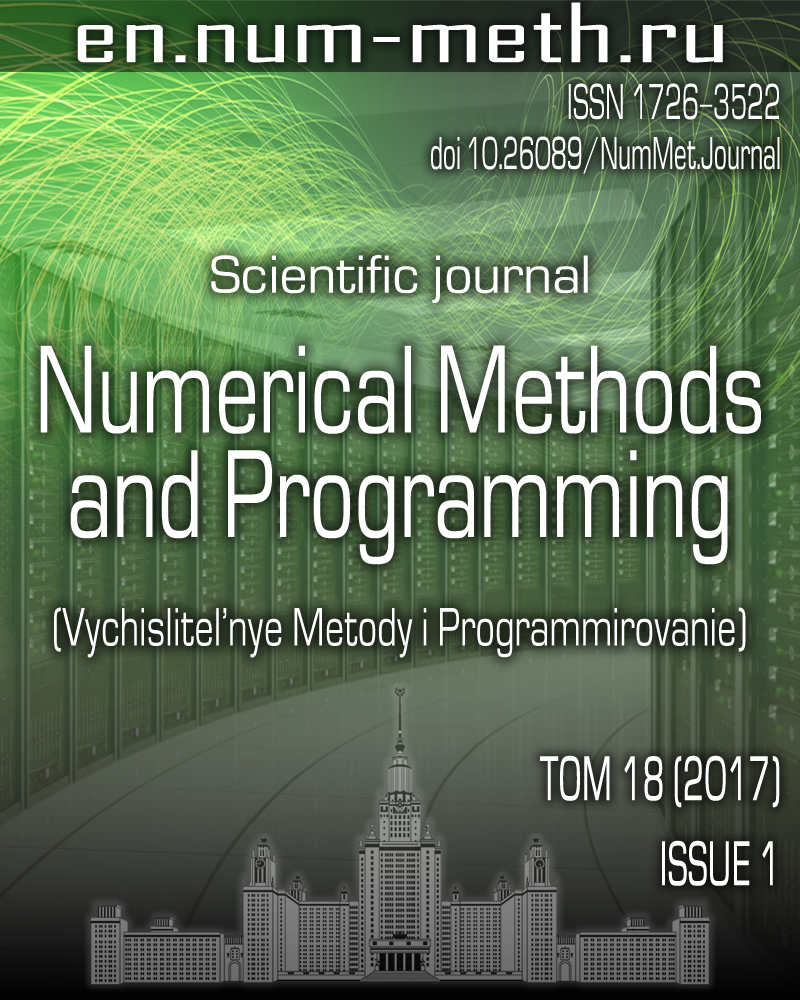DOI: https://doi.org/10.26089/NumMet.v18r103
Flows of ideal and real gases in channels of variable cross section with unsteady localized energy supply
Keywords:
Abstract
Gas flows are simulated in technical devices where processes associated with unsteady localized energy supply are proceeded. The finite volume method and the vectorized approach to the calculation of numerical fluxes are applied to the simulation of unsteady nozzle flows with intense energy supply. An approximate model of equilibrium thermodynamics of air is used to simulate thermodynamic processes in high-temperature air flows. The numerical results obtained for one-dimensional and two-dimensional nozzle flows with moving zones of energy supply are analyzed. A qualitative picture of gasdynamic and thermal processes in a nozzle with unsteady energy supply is discussed on the basis of the results of numerical simulation. A dependence of the nozzle flow rate and the displacement of nozzle shock wave on the intensity and cyclicity of energy supply is considered for overexpanded nozzle flow.
Published
Issue
Section
References
- V. P. Zamuraev and A. P. Kalinina, “Gasdynamic Effects of Periodic Energy Input into a Divergent Channel,” Zh. Tekh. Fiz. 80 (1), 41-44 (2010) [Tech. Phys. 55 (1), 40-43 (2010)].
- V. A. Zabaikin, “Control of Pseudo Shock by Non-Stationary Effect,” Fiz. Khim. Kinetika Gaz Dinam.
http://chemphys.edu.ru/issues/2011-12/articles/353 . Cited January 17, 2017. - A. F. Latypov, “Numerical Simulation of the Flow in a Variable-Section Channel with Pulsed-Periodic Energy Supply,” Zh. Prikl. Mekh. Tekh. Fiz. 50 (1), 3-11 (2009) [J. Appl. Mech. Tech. Phys. 50 (1), 1-8 (2009)].
- M. T. C. Fang, Q. Zhuang, and M. Y. Shen, “The Computation of Axisymmetric, Supersonic Nozzle Arc Using Adaptive Grids,” IEEE Trans. Plasma Sci. 22 (3), 228-234 (1994).
- J. D. Yan, M. T. C. Fang, and C. Jones, “Electrical and Aerodynamic Behavior of Arcs under Shock Conditions,” IEEE Trans. Plasma Sci. 25 (5), 840-845 (1997).
- S. T. Surzhikov, “Radiative-Gasdynamical Model of a Nozzle with Local Heating,” Mat. Model. 9 (9), 54-74 (1997).
- I. V. Yegorov and D. V. Ivanov, “Simulation of the Flow with Nonequilibrium Chemical Reactions in a Channel of Various Crossection,” Mat. Model. 9 (11), 85-100 (1997).
- A. A. Zheltovodov and E. A. Pimonov, “Numerical Simulation of an Energy Deposition Zone in Quiescent Air and in a Supersonic Flow under the Conditions of Interaction with a Normal Shock,” Zh. Tekh. Fiz. 83 (2), 21-35 (2013) [Tech. Fiz. 58 (2), 170-184 (2013)].
- K. N. Volkov, V. N. Emelyanov, and A. V. Pustovalov, “Supersonic Flows of an Inviscid Compressible Gas in Aerodynamic Windows of Gas Lasers,” Vychisl. Metody Programm. 15, 712-725 (2014).
- K. N. Volkov and V. N. Emelyanov, “Implementation of Vectorized Finite-Difference Algorithms for Solving Boundary Value Problems of Fluid and Gas Mechanics with MATLAB Package,” Vychisl. Metody Programm. 5, 13-19 (2004).
- V. A. Levin, V. G. Gromov, and N. E. Afonina, “Numerical Analysis of the Effect of Local Energy Supply on the Aerodynamic Drag and Heat Transfer of a Spherically Blunted Body in a Supersonic Air Flow,” Zh. Prikl. Mekh. Tekh. Fiz. 41 (5), 171-179 (2000) [J. Appl. Mech. Tech. Phys. 41 (5), 915-922 (2000)].
- A. N. Kraiko, “Analytic Representation of the Thermodynamic Functions of Air,” Inzh. Zh. 4 (3), 548-550 (1964).
- P. Glaister, “An Approximate Linearised Riemann Solvers for the Euler Equations for Real Gases,” J. Comput. Phys. 74 (2), 382-408 (1988).
- A. Yu. Semenov, “A Modified Courant-Isaacson-Rees Method for Gas Dynamics with an Arbitrary Equation of State,” Zh. Vychisl. Mat. Mat. Fiz. 37 (11), 1376-1383 (1997) [Comput. Math. Math. Phys. 37 (11), 1334-1340 (1997)].
- P. Colella and H. M. Glaz, “Efficient Solution Algorithms for the Riemann Problem for Real Gases,” J. Comput. Phys. 59 (2), 264-289 (1985).
- M. Vinokur and Y. Liu, “Equilibrium Gas Flow Computations II: An Analysis of Numerical Formulations of Conservation Laws,” AIAA Paper No. 88-0127 (1988).
- B. Grossman and R. W. Walters, “Analysis of Flux-Split Algorithms for Euler’s Equations with Real Gases,” AIAA J. 27 (5), 524-531 (1989).
- M.-S. Liou, B. van Leer, and J.-S. Shuen, “Splitting of Inviscid Fluxes for Real Gases,” J. Comput. Phys. 87 (1), 1-24 (1990).
- H. Yan, R. Adelgren, M. Boguszko, et al., “Laser Energy Deposition in Quiescent Air,” AIAA J. 41 (10), 1988-1995 (2003).
- A. N. Kucherov, “Several Aspects of Gas Flow with Prescribed Distribution of Heat Sources,” Uchen. Zap. TsAGI 40 (4), 3-14 (2009) [TsAGI Sci. J. 40 (4), 401-417 (2009)].
License
Copyright (c) 2017 Вычислительные методы и программирование

This work is licensed under a Creative Commons Attribution 4.0 International License.


